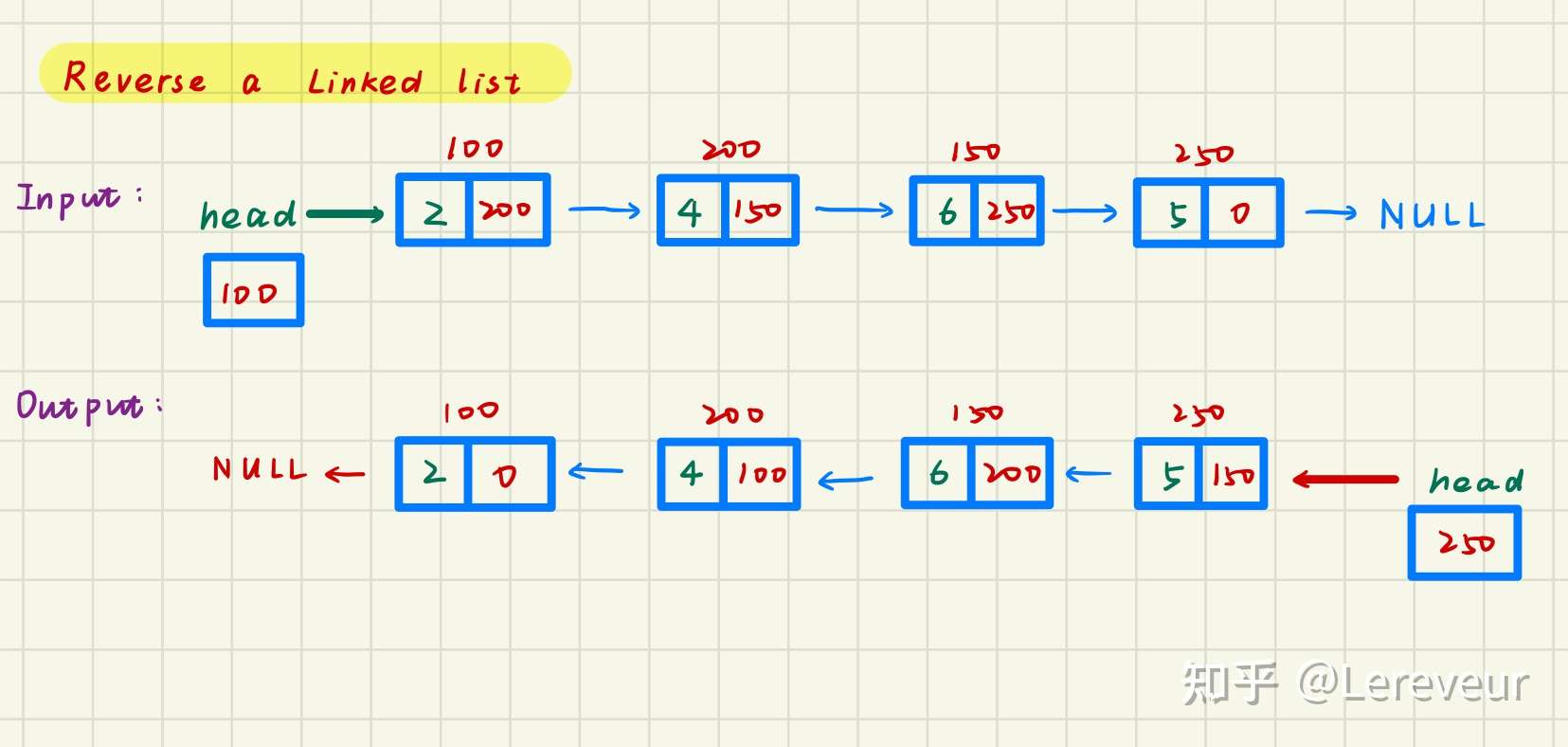
从上图中可以看出,反转一个链表只需要改变Node.link。
I. 迭代实现
思路
设置三个结构体指针Prev、current、next,分别保存之前的节点的地址、目前的节点地址、之后的节点地址。
代码实现
1
2
3
4
5
6
7
8
9
10
11
12
| void Reverse(){
struct Node *current, *prev, *next;
current = head;
prev = NULL;
while(current != NULL){
next = current->next;
current->next = prev;
prev = current;
current = next;
}
head = prev;
}
|
完整代码如下:
1
2
3
4
5
6
7
8
9
10
11
12
13
14
15
16
17
18
19
20
21
22
23
24
25
26
27
28
29
30
31
32
33
34
35
36
37
38
39
40
41
42
43
44
45
46
47
48
49
50
51
52
| #include<stdio.h>
#include<stdlib.h>
struct Node{
int data;
struct Node* next;
};
struct Node* head;
void Insert(int n){
struct Node* temp = (struct Node*)malloc(sizeof(struct Node));
temp->data = n;
temp->next = NULL;
struct Node* temp1 = head;
if(head == NULL){
head = temp;
return;
}
while(temp1->next != NULL){
temp1 = temp1->next;
}
temp1->next = temp;
}
void Print(){
struct Node* temp = head;
while(temp != NULL){
printf("%d ",temp->data);
temp = temp->next;
}
printf("\n");
}
void Reverse(){
struct Node *current, *prev, *next;
current = head;
prev = NULL;
while(current != NULL){
next = current->next;
current->next = prev;
prev = current;
current = next;
}
head = prev;
}
int main(){
head = NULL;
Insert(2);
Insert(4);
Insert(6);
Insert(5);
Print();
Reverse();
Print();
return 0;
}
|
输出结果:
II. 递归实现
1)递归实现输出的反转
我们先写一个递归形式的Print函数,因为递归需要给函数传参,因此函数形式为Print(struct Node* p)。
1
2
3
4
5
6
7
8
| void Print(struct Node* p){
if(p == NULL){
printf("\n");
return;
}
printf("%d ",p->data);
Print(p->next);
}
|
此时总是先输出再调用函数自身,因此是正向输出。如果我们将printf与Print两行代码交换位置,即
1
2
3
4
5
| void Print(struct Node* p){
if(p == NULL) return;
Print(p->next);
printf("%d ",p->data);
}
|
那么函数会在输出之前先进行重复调用,进行到递归结束条件后,依次执行输出。
完整代码如下
1
2
3
4
5
6
7
8
9
10
11
12
13
14
15
16
17
18
19
20
21
22
23
24
25
26
27
28
29
30
31
32
33
34
35
36
37
38
39
40
41
42
43
44
| #include<stdio.h>
#include<stdlib.h>
struct Node{
int data;
struct Node* next;
};
struct Node* head;
void Insert(int n){
struct Node* temp = (struct Node*)malloc(sizeof(struct Node));
temp->data = n;
temp->next = NULL;
struct Node* temp1 = head;
if(head == NULL){
head = temp;
return;
}
while(temp1->next != NULL){
temp1 = temp1->next;
}
temp1->next = temp;
}
void Print(){
struct Node* temp = head;
while(temp != NULL){
printf("%d ",temp->data);
temp = temp->next;
}
printf("\n");
}
void ReversePrint(struct Node* p){
if(p == NULL) return;
ReversePrint(p->next);
printf("%d ",p->data);
}
int main(){
head = NULL;
Insert(2);
Insert(4);
Insert(6);
Insert(5);
Print();
ReversePrint(head);
return 0;
}
|
输出结果
2)递归实现链表反转
反转输出并没有实现链表的反转,因为head、next的值都没有发生改变。但是我们依然可以采用递归的方式实现链表的反转。
设计一个Reverse函数,使得其能够以递归方式实现链表反转。
1
2
3
4
5
6
7
8
9
10
| void Reverse(struct Node* p){
if(p->next == NULL){
head = p;
return;
}
Reverse(p->next);
struct Node* q = p->next;
q->next = p;
p->next = NULL;
}
|
完整代码如下
1
2
3
4
5
6
7
8
9
10
11
12
13
14
15
16
17
18
19
20
21
22
23
24
25
26
27
28
29
30
31
32
33
34
35
36
37
38
39
40
41
42
43
44
45
46
47
48
49
50
| #include<stdio.h>
#include<stdlib.h>
struct Node{
int data;
struct Node* next;
};
struct Node* head;
void Insert(int n){
struct Node* temp = (struct Node*)malloc(sizeof(struct Node));
temp->data = n;
temp->next = NULL;
struct Node* temp1 = head;
if(head == NULL){
head = temp;
return;
}
while(temp1->next != NULL){
temp1 = temp1->next;
}
temp1->next = temp;
}
void Print(){
struct Node* temp = head;
while(temp != NULL){
printf("%d ",temp->data);
temp = temp->next;
}
printf("\n");
}
void Reverse(struct Node* p){
if(p->next == NULL){
head = p;
return;
}
Reverse(p->next);
struct Node* q = p->next;
q->next = p;
p->next = NULL;
}
int main(){
head = NULL;
Insert(2);
Insert(4);
Insert(6);
Insert(5);
Print();
Reverse(head);
Print();
return 0;
}
|
